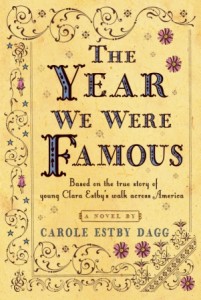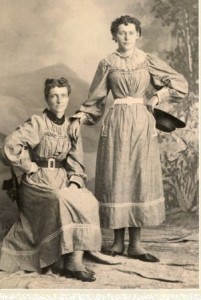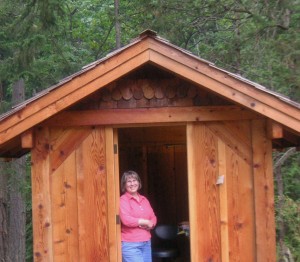Author Carole Estby Dagg
Instead of writing books, I became a librarian, surrounding myself with books other people had written. Clara and Helga’s story kept nagging me, though, so for their sake I decided to risk rejection. If they had repeatedly risked their very lives to prove women could walk across the country on their own, how could I be afraid of something as innocuous as a rejection letter?
Carole Estby Dagg is the author of The Year We Were Famous, the story of her great grandmother and great aunt’s walk across America in 1896. As a child, books served as loyal companions to Carole as the family moved a dozen times due to her father’s career as a construction engineer. She has worked as a CPA, children’s librarian, and assistant library director. Married with two grown children and two grandchildren, she writes in Everett,Washington and in a converted woodshed on San Juan Island under the supervision of her bossy cat.
Carole, thank you for visiting with Healing Hamlet! Please tell us what inspired you to write The Year We Were Famous? Why do you feel the story of these women needed to be told?
Newspapers repeatedly reported that Clara and Helga intended to write a book about their adventures, but because of the way the trip ended, all their records were burned and the family agreed never to talk about the trip again. Times change. What was considered scandalous back in 1896 would be considered heroic today. It was time their story was told.
It seems that fate had decided long ago that I would be the one to tell that story. I found out after the book launched that I had been the only child allowed into the hospital to see Great-aunt Clara before she died.
It was a long journey from the inception of your book to its publication. During the process did you feel a connection to your great aunt and great grandmother and their own journey?
I didn’t inherit Clara and Helga’s extraordinary physical strength – I can’t imagine walking 25-40 miles a day, day after day for seven and a half months. I did inherit the perseverance gene though. I took each rejection as a sign that I needed to try another approach, or that I needed to work more on craft. During the fifteen years of rejections, I rewrote the book from Helga’s point of view, Clara’s point of view, as diary, as narrative, first person, third person, at least a dozen or more complete re-writes. I also took eight college-level writing classes and attended at least a dozen workshops. Just as they kept focused on their goal, one step at a time, I kept writing and re-writing, one word at a time, until I found a publisher.
Before the publication of your book, you won the Sue Alexander Award for most promising new work. The prize provided you with a flight from Washington State to New York City. After the years you dedicated to the story of your ancestors’ 232 day trek across that same distance, what were your thoughts during that trip?
The flight to New York was a blur. What really aroused my empathy for Clara and Helga on their trek was a road trip with my daughter, driving part of the route that Clara and Helga took across the country. As we drove hundreds of barren miles across Wyoming, I thought about how desperately alone Clara and Helga must have felt, sleeping in the open and walking for days without seeing another person.
The women in your book began their journey as a way to stave off financial ruin. There is also the perception that your great-grandmother suffered bouts of depression. How was this journey healing for these women? How can the story be healing for the reader?
The book started as an episodic adventure story, based on newspaper accounts of their survival of flash flood, attack, Indian encounters, being lost for days without food or water, and meeting President-elect McKinley. What my first editor at Clarion, Jennifer Wingertzahn, made me realize was that this was also a mother-daughter story describing how a mercurial, outgoing mother and methodical, shy daughter would come to understand and forgive each other during the time they were yoked together for the 232-day trek.
What had always inspired me, growing up and hearing snippets of the story, was not that they came home empty-handed, but that they did it: They walked four thousand miles, relying only on themselves, their faith, and the kindness of strangers. They did not give up, but kept headed toward their goal of New York City by putting one foot in front of the other, for eight million steps, until they reached their goal. The New York World wrote that they expected to write a book “if they survived.” They did survive, despite public opinion that the trek was impossible. I hope the book inspires readers to persevere toward their goals too.
How would you describe the internal process of writing this book? Was the experience healing for yourself?
My grandmother predicted that I would grow up to be a writer, but I had convinced myself that I didn’t have innate writing talent and I would be setting myself up for disappointment if I tried. Instead of writing books, I became a librarian, surrounding myself with books other people had written. Clara and Helga’s story kept nagging me, though, so for their sake I decided to risk rejection. If they had repeatedly risked their very lives to prove women could walk across the country on their own, how could I be afraid of something as innocuous as a rejection letter? Over a period of fifteen years, I collected 29 rejection slips, but I kept revising and resubmitting. I was finally accepted by my first choice publisher, Clarion/Houghton Mifflin, a house that had rejected me twice before.
As a librarian and book lover, how have you witnessed books to be healing?
For children and teens especially, books offer a risk-free way to have adventures and experience other lifestyles and periods of history. In books, readers may discover characters facing problems similar to their own, and see how those characters faced challenges such as divorce, death of a parent, bullies at school, or having to eat at the outcasts’ lunch table. Readers can also gain perspective and strength by reading about characters, real and fictional, who faced problems far greater than their own.
What is your next project?
I wrote a sequel to The Year We Were Famous which imagines how Clara adjusted to her tragic homecoming in 1897 and broke into the man’s world of business, but haven’t found a publisher yet. I’m also working on a book set in Alaska Territory during the Great Depression.
What books and writers do you find inspiring?
As a child moving every few months, my constants were my two sisters and the friends I made in books. Wherever we moved, I could reunite myself with Lucy Maud Montgomery’s Anne of Green Gables, Maud Hart Lovelace’s Betsy, Tacy and Tib or Elizabeth Enright’s Melendy series. My real life friends lasted only the few months I was in town, but my book friends were always waiting for me in the next library. The characters in those books demonstrated how love and friendship can withstand challenges and the mistakes imperfect people make.
Carole, thank you so much for telling the story of Helga and Clara, and for sharing your own inspiring story with Healing Hamlet!
Learn more about The Year We Were Famous and Carole Estby Dagg on her website.
- Posted in: Healing ♦ Interviews ♦ Carole Estby Dagg ♦ The Year We Were Famous




